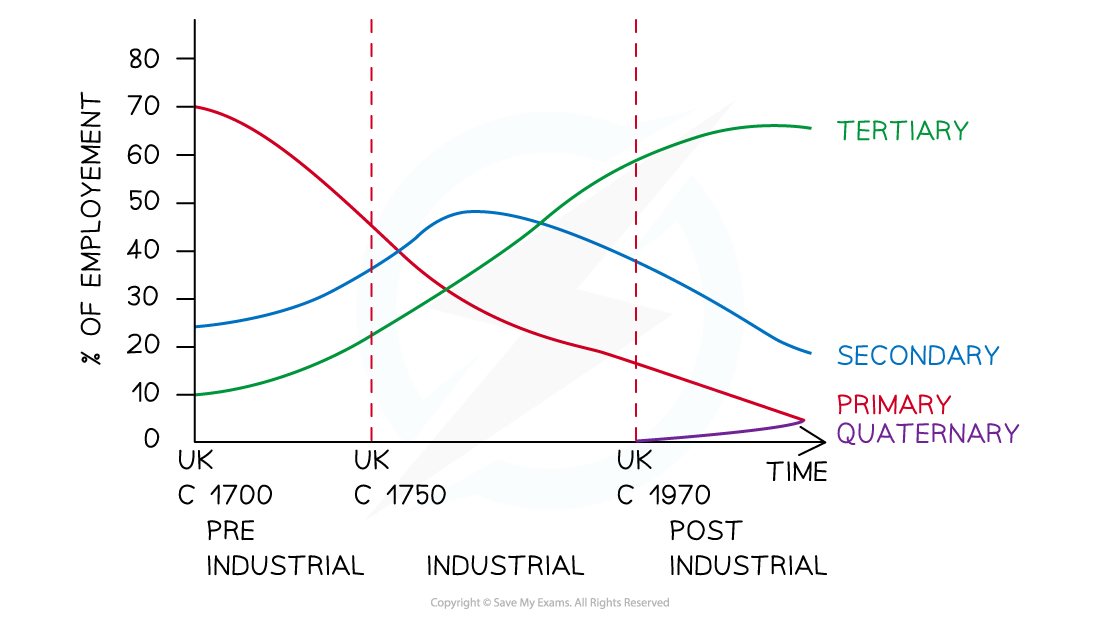National & International Migration
- Over the last 50 years, the UK's population has grown by nearly 20% (10 million people)
- Growth is due to 2 processes:
- Natural increase: where births are exceeding deaths
- Net migration: where in-migration exceeds out-migration
- Migration can be split into 2 types:
- Internal or national migration
- International or external migration
What is migration?
- Migration is the movement of people across an official boundary, either internationally or nationally, with the intention of creating a permanent place of residence
- The UN defines the term 'permanent' as a change of residence for more than 1 year
Impact of national migration on the UK
- Migration has shaped the UK and has impacted economically, culturally, politically and environmentally
- The UK's economic development was the largest impact on the population density
- Prior to the 18th century the majority of UK residents lived in rural areas, relying on agriculture as their main form of employment
- During the 19th century the industrial revolution saw a rapid rise in the number of people concentrated in cities as they migrated from the rural regions seeking employment in the better paying secondary sector
- Now in the UKs post-industrial phase, the population is spread around the cities, with urban sprawl a common feature
- This internal migration has led to the population density of the modern UK, where the majority of people live in urban areas
Impacts of international migration on the UK
- The UK has always experienced waves of migrants
- During the 1850s Irish famine
- 1950s from West Indies, seeking employment
- From eastern Europe after EU enlargement and removal of barriers
- Refugees from Syria and Ukraine etc.
Out of the 59.6 million usual residents in England and Wales in 2021, 49.6 million (83.2%) were born in the UK and 10.0 million (16.8%) were born outside the UK. This means that about one in six people in England and Wales were born outside the UK - ONS 2021 census - International migration, England and Wales - Office for National Statistics (ons.gov.uk)
- India is still the most popular country of origin, with significant migration from Pakistan, Ireland and Poland
Table of the Effects of Migration
| Positive | Negative |
| Skills gaps are filled | Pressure on services, housing and infrastructure |
| Culture is enriched | Discrimination and racial tensions (immigrant seen as stealing jobs) |
| Birth rates are boosted | Overcrowding and congestion |
| More low-wage workers | Job competition |
| Support family in country of origin through remittances | Language barriers and cultural assimilation |
| Government tax revenue increases | Gender imbalance - more men tend to migrate than women |
| Education opportunities as universities are found in UK cities | Migrants tend to be located together in large city areas |
| Youthful, single population and vibrant nightlife | Families and retiring couples move out looking for a quieter, safer and less polluted environment |
- Not all UK citizens believe that immigration and multiculturalism are good for the UK
- This was one of the main points of the Brexit vote of 2016
- It has created tensions and conflict between communities, along with hate crimes against ethnic minorities
Regional Differences
- Most immigrants settle in urban areas due to job opportunities
- This has contributed to the UK's urbanisation over the last 50 years
- London is the most popular destination for immigrants
- More people left Northern Ireland than in-migrated in 2016
- The UK's south coast is a popular retirement area due to warmer than average UK temperatures
Immigration and age structure
- Most immigrants are young with young families of their own
- This impacts the UK age structure (source: ONS 2022):
- In 2021, 28.8% of live births were to non-UK-born women; a decrease from 29.3% in 2020
- The total fertility rate (TFR) increased for UK-born women to 1.54 children per woman; the TFR for non-UK-born women remained at 2.03 children per woman
- In 2021, the most common country of birth for non-UK-born fathers was Pakistan; and Romania was the most common country of birth for non-UK-born mothers
- The UK is becoming an ageing population

The changing age structure of the UK's population, 2005 and 2015




